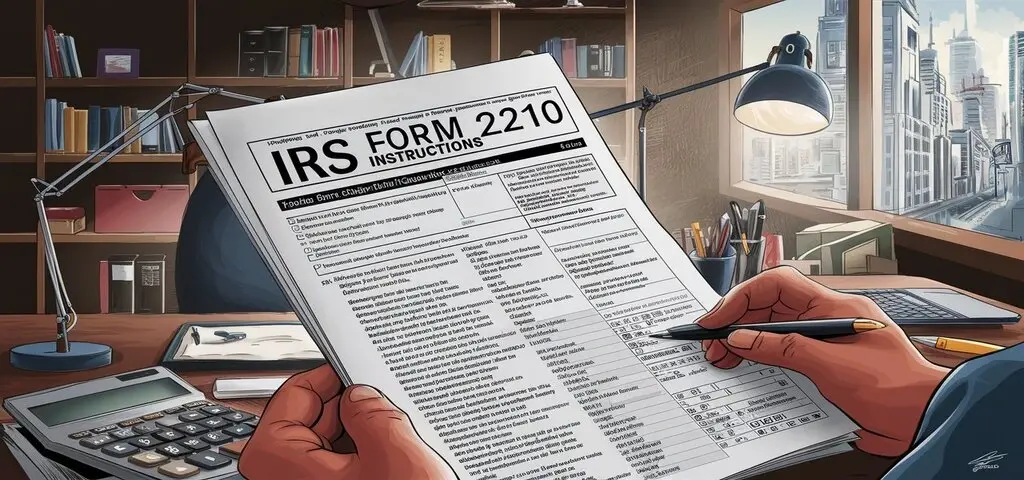
Penalties that might be payable are computed and paid using IRS Form 2210 when projected tax payments fall short of the annual tax liability. If you did not pay enough taxes—expectedly paid through withholding from your pay or the estimated tax payments made every quarter—you must submit this Form. Refer to Form 2210 for computing fines; following these basic guidelines will help you to find this easier.
Should it be necessary to file Form 2210, you could find yourself obliged to:
After submitting their tax return, they pay taxes yearly totaling $1,000 or more.
Through withholding of taxes or projected quarterly tax payments, you did not pay at least 90 percent of your total tax burden during the year.
The preceding computations clearly show that you underpaid your expected quarterly payments and can be liable for an underpayment penalty.
Still, there are several circumstances in which you are not required to file Form 2210 even if you underpaid your taxes. For example, the average amount will not fairly reflect the truth if your income is erratic or mostly in the latter half of the year.
You would have to review the list of exceptions included in the Form 2210 instructions.
First step: Find and total all current taxes that affect you to get an overall picture.
The first section is figuring out the total taxes you will have to pay for the year excluding estimations and taxes already paid through withholding. You fill in your usual 1040 tax return form right down to all the income, deductions, credits, etc., and then the number on 1040 Line 16 and less Schedule 3 Line 9 is the total tax you owe. Jot this number down.
Choose your last step based on your current tax-paid amount. Now figure out your current annual tax paid using: All Forms W-2's Box 2 shows your total federal income tax withheld from your pay. Including on 1040 Schedule 3, Line 9, your estimated and paid tax obligations during the year. Arriving at the total of these two values will be This is the tax percentage you paid all year before submitting your tax return.
Third step: They also have a Single Touch Payroll action plan and a twofold underpayment penalty computation right under them.
Iron this total the money you have already paid in line with Step 2 from the figure derived in Step 1. Should the difference be $1,000 or greater, you will have underpaid your taxes and can face penalties.
Step 4: Decide on Exceptions
There are specific circumstances, though, whereby an underpayment penalty will not apply even if you underpaid your taxes due to paying little tax over the year. Typical outlays include:
Your tax payments for the current or previous tax year complied, more precisely your payments were at least 90% of what you owed in taxes.
One could say that You either largely made money in the latter few months of the year or had varying income.
Visit this link to learn further about Form 2210's stated penalty exception policy:
Step 5 in Choose the Time Horizon.
Should no exemption apply, you will be required to select one of the following calculating periods to ascertain your penalty:
Standard option: Based on the four period's equivalent of one period—one quarter—which relates to the date of return filing—the penalty is calculated.
Even more complex than previous ones, annualized options divide the year into periods based on income receipt.
If your income changed during the year, carry-forward options came in handy. The usual approach is more comfortable otherwise.
Step 6: Penalty has to be calculated either in Part I ( Standard Method) or Part II (Annual Method).
The computation period you choose in step 5 indicates you fill part or part I of form 2210, the standard method or part II of form 2210, which is the annualized installments technique to determine your underpayment penalty. Follow all the guidelines to guarantee accurate computation of the total penalty due.
The seventh step should be recorded on Form 1040 as the penalty amount.
Form 1040 Line 38 under the heading of other taxes shows your underpayment penalty amount. All you have to do is move Form 1040 Line 38 to the total penalty from Form 2210 Line 17 (standard method) or the Schedule AI Line 35 (annualized approach). Every time you file, your 2210 form must be completed and linked to form 1040.
Pay Back the Debt.
Should an underpayment penalty apply, it is paid when you file your Form 1040 for that particular year. As a defaulting taxpayer, it forms a portion of the overall taxes you owe the IRS. Ignoring the obligation could draw extra fees and penalties as well as accrued interests until the amount is paid off completely.
This guarantees correct filing of Form 2210 and payment of any fines should you underpay your taxes for the year. A tax specialist should also be consulted to ascertain whether this form is suitably completed. This book does, however, give a general picture of how to ascertain and document Estimated Tax Underpayment PEN Penalties.
Contact us here for accounting services now!

Get Help Fast!
My Accounts Consultant Helps Accounting & Bookkeeping Services help you save money, better understand your business and find the Accounts problems before they hurt you.